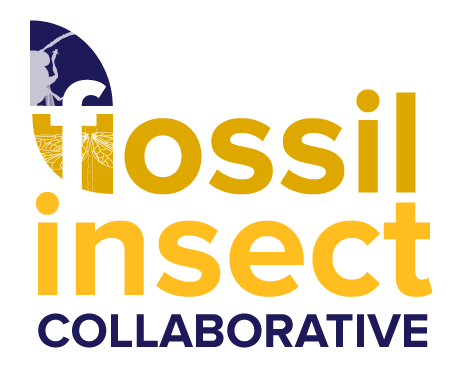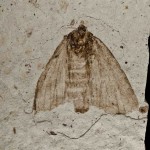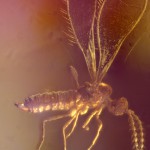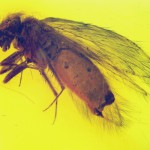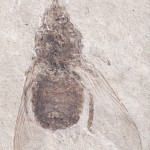Most people, when they hear the word fossil, imagine dinosaurs – large, fearsome, creatures. Or perhaps they think of more recently extinct animals, like saber-toothed cats or wooly mammoths. If they have experience of collecting, they might be familiar with the more commonly encountered fossils: clamshells, shark’s teeth, or the coiled shells of ammonites (extinct relatives of today’s squid and octopus). But it’s quite unlikely that they would think of fossil insects. In school, you’re taught that fossils usually preserve only the hard parts of organisms – shells, teeth, or bone. The bodies of insects seem too small and too fragile to survive long enough to be preserved as fossils. But insects also have hard parts, including a tough external skeleton, and given the right set of circumstances even some of the tiniest of them – animals the size of a mosquito – can be preserved as fossils.
For scientists, this is incredibly important. While large animals like dinosaurs may capture the attention of the public, and provide important information about evolution, there are just too few of them to do the sort of large-scale studies on past environments that we need if we’re going to understand the current effects of climate change. Fossils are one of the most important pieces of evidence for a changing climate. And insects are the most abundant and diverse group of animals on the planet. So having access to insect fossils gives researchers a window into what the world looked like millions of years ago, when the climate was quite different.
One of the best-known examples of this type of evidence is an extinct group of insects called the griffinflies, which lived around 300 million years ago. Griffenflies looked quite similar to their modern relatives, the dragonflies that you might see hawking around the edge of a pond on a summer day. But some of them grew to huge sizes. Meganeura, the largest one known, had a wingspan of more than 2 feet, nearly three times bigger than the atlas moth, which has the greatest wingspan of living insects.
Why don’t we get insects that big today? Insect size is limited by their method of breathing. Instead of having lungs, insects have a network of tubes that connect the interior of the body with the outside world. Oxygen diffuses along these tubes – if the tubes become too long, not enough oxygen can reach the farthest parts of the body. But if the amount of oxygen in the air was higher, the tubes could be longer, and so the animal could grow bigger. Fossils like Meganeura are evidence that 300 million years ago, there was much more oxygen in the atmosphere than there is today; 35% of the atmosphere was composed of oxygen compared with 21% today.
It’s not just the size of insects that provides evidence about climate change, but also where you find them. The tsetse flies are a scourge of modern Africa. They carry a parasite that causes sleeping sickness, a disease that effects humans and their livestock. In the areas where tsetse flies occur, the middle of Africa between the Sahara and Kalahari deserts, sleeping sickness has devastated agriculture and human health and is a major source of rural poverty.
Fortunately for the rest of the world, tsetse flies are confined to the 20 countries that occupy that middle belt of the African continent. But 34 million years ago, they were much more widely distributed. We know this because their fossils are found in the Florissant Fossil Beds of Colorado. The fossils look much like modern day tsetse flies, but they are found thousands of miles away, and much further north than their modern relatives. Today, the climate of Colorado doesn’t have much in common with the African tropics, but when the Florissant fossils were formed, the planet was much warmer and wetter than it is today. In Colorado, the mean annual temperature was around 13-15 Celsius, compared with only 4 Celsius today, in part because winters were much milder. And the reason for this was that the levels of greenhouse gasses in the atmosphere were much higher than they are today.
This information is important, because as levels of greenhouse gasses continue to rise, our descendants will be living in a world where insect distributions have also changed, meaning that they may face challenges to health and agriculture from pests and diseases that we don’t currently encounter where we live. Predicting what these future threats may be requires modeling how distributions of insects and other animals and plants change in response to a changing climate. Fossil evidence is one important component of the science that underpins those models.
But to use that fossil evidence, you need to be able to access it, and that’s a challenge because collections of fossil insects are scattered across many different museums and collections. That’s why the National Science Foundation is supporting the Fossil Insect Collaborative, a multi-institution project that aims to capture data and images from more than half a million insect fossils and make them available via the web. We’re also developing a web-based tool called iDigPaleo, which will let users – be they researchers, students, teachers, or interested members of the public – interact with these fossils on-line: view them; write notes; map and measure them; and build and their own virtual collections. You can find out more about this at www.idigpaleo.org.
